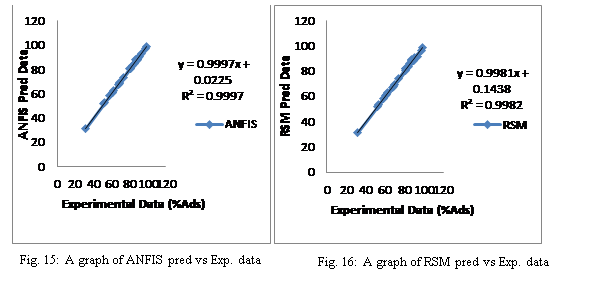Multi-Input Single Output (MISO) modelling with Adaptive Neuro Fuzzy Inference System (ANFIS) and Response Surface Methodology (RSM) for adsorptive removal of Erythrosine B dye from wastewater using activated carbon derived from agrowaste
Keywords:
Adsorption, ANFIS, RSM, tamarind seeds, kinetics, genetic algorithmAbstract
The adaptive neuro-fuzzy inference system (ANFIS) and response surface methodology (RSM) were employed to model erythrosine B (EB) dye adsorptive uptake from wastewater using acid and thermal activated tamarind seeds (Dialium guineese) as adsorbent. Fourier Infrared Spectroscopy and Scanning Electron Microscopy were used to identify the functional groups and surface morphology of the tamarind seed activated carbon (TSAAC) respectively. The adsorption kinetics of EB dye uptake on TSAAC was described by the pseudo-first order (PFO), pseudo-second order (PSO), Elovich and Intra-particle diffusion models. Analysis of Variance was employed to determine if there is a statistical significance difference between the percentages of EB dye adsorbed on TSAAC at various time intervals and Tukey’s HSD post hoc analysis to spot where these differences occurred. RSM and ANFIS models were evaluated using the coefficient of determination (R2), Marquadt’s Percent Standard Deviation (MPSD), The hybrid fractional error function (HYBRID) and Average Relative Error (ARE) metrics. Results revealed that the PSO model best fitted the kinetics experimental data when compared with the Elovich and PFO models. Intra-particle diffusion plots showed that there are other rate-limiting steps that control the adsorptive process besides intra-particle diffusion. ANOVA results established statistically significant difference between the percentages of EB dye adsorbed on TSAAC at various time intervals. Both RSM and ANFIS recorded high coefficient values of 0.999 and 0.998 indicating strong predictive capability in predicting the adsorption of EB dye. Further statistical investigations revealed that ANFIS outperformed RSM in approximating the nonlinear behaviour of the adsorptive system. An optimum adsorption efficiency of 96.73% was achieved using genetic algorithm. This study has successfully revealed the capability of both RSM and ANFIS in modeling the adsorptive removal of EB dye using TSAAC.


